This Guest post by my husband, Guy Cowper shares the excitement of an encounter with the Desert Elephants of Namibia on a recent month-long adventure trip with the school where he works.
“I knew as soon as a saw the converted pickup truck outside the Brandberg White lady lodge that the drive to see Namibia’s legendary desert elephants would be fun. Even the words Damaraland; White lady Lodge; Elephant; seemed exciting and exotic”
This article may contain affiliate links that provide commission on purchases you make at no extra cost to you. As an Amazon Associate I earn from qualifying purchases.
Stone age rock paintings in Namibia
The sun-lit and magnificent Brandenburg mountains, home to Namibia’s highest mountain the Konigstein ( 2606m) provided a perfect mysterious backdrop to the forthcoming adventure. The stone-age rock paintings of the San bushmen here give evidence of the presence of the famous desert elephants in the area many thousand years ago and it is clear that man, so far, has had no impact since the earth’s early days and I felt small and in awe.
The Ugab River Valley in Namibia
I was lucky enough to be with some sixth form girls from the where I work, who were in party mood as we set off to drive along the dried up Ugab river bed that would lead us to the elephants.
The Ugab River Valley is in the Kunene Region, encompassing 115,154km2 of mostly sandy desert, rocky mountains and arid gravel plains in Namibia’s northwest. The Ugab banks with its old trees and green bushes is home to a wide variety of game, birds, fascinating reptiles and of course elephants.
As we were visiting in July (which is Namibia’s winter and one of the drier periods of the year) groups of desert elephant congregate in the valley of the Ugab river as there is no worry for water and bush and trees to feed on in abundance.
On the way our guide explained about what we would see and how we must behave so that the elephants and a month old baby would not be disturbed. Note there was no doubt, unlike many safaris, that you will see elephant and I can verify that you won’t see lots of other vehicles.
You may also enjoy: What to expect on a Private Game Reserve Safari in South Africa
Why are there elephants in the desert?
Our guide addressed the question in everyone’s mind “why are there elephants in the desert? ” In the 1980’s the population of desert adapted elephants in the Southern Kunene Region of Damaraland were wiped out through years of poaching and hunting. For years elephants were absent from the area. This was until 1998 when Voortrekker, a bull, lead Mama Africa’s herd back to the Ugab River.
From that point other herds followed until today where there are a total of 7 elephant herds in the Ugab and Huab River vicinities. I later found out that through concerted efforts by the Ministry of Environment and Tourism (MET), IRDNC, Save the Rhino Trust and other NGO’s over the past 20 years, the population of desert dwelling elephants in the region has grown from as low as 52 members to a current population of over 600 elephants.
I’m grateful to the EHRA web site for this information and can vouch that the Elephant Human Relations Aid EHRA aims to find long-term sustainable solutions to the ever-growing problem of facilitating the peaceful cohabitation between the subsistence farmers, community members and the desert adapted elephants.
Elephants adapted to the desert
Extraordinarily these elephants have adapted to their dry, semi-desert environment by having a smaller body mass with proportionally longer legs and seemingly larger feet than other elephants. Their physical attributes allow them to cross miles of sand dunes to reach water.
They have even been filmed sliding down a dune face to drink at a pool in a desert oasis. They survive by eating moisture-laden vegetation growing in ephemeral riverbeds and with their ability to go several days without drinking water. Sometimes they must travel long distances to reach a water source.
Elephants living in small family groups
By living in smaller than average family units of only two or three animals, they decrease pressure on food and water resources. This certainly seems to be the case and the local Damara guides took real pleasure in their elephants. Researchers have noted that they destroy fewer trees than elephants living in higher rainfall areas in other parts of Africa.
There is only one other group of desert-dwelling elephants in the world. They live in Mali, North Africa, where they were forced into their desert habitat by human population expansion. These elephants also belong to the genus Pachyderms, meaning “thick skinned”, the genus includes rhinoceroses as well.
Although not a separate species, and not much different from other Savannah elephants Loxodonta africana africana, Namibia’s desert-dwelling elephants are special nonetheless. They are of high national and international conservation priority, and have been designated as top priority for protection by the IUCN (International Union for the Conservation of Nature).
Sighting the desert elephants
By now we were in low gear driving along the Ugab river bed eyes scanning the bank for movement and elephant. And wow a huge tree shook to my left as the bull broke a branch. We stopped and waited while the herd of six slowly and nonchalantly went about its business crossing the river bed to the sample leaves on the other side.
I do not have the words to describe the emotion or the sight of these magnificent creatures emerging from the pristine landscape and crossing within 5 metres of our truck. Even the girls in the party were quieted by the spectacle until the month old baby appeared that is! This little fellow was gorgeous, if a little fractious, at being moved on by mum.
An hour passed before we reluctantly withdrew for the hours drive back to the lodge under the ever-changing patterns of the Brakenberg mountain at sunset which, unlike, the equator, are slow to fade to the cold of evening. We arrived back tired but in awe. I asked one of the girls for her thoughts – after some reflection I was rewarded with the words my own mind had considered;
“Simply magnificent animals, simply marvellous experience”.
Read Next
Read about Water in the desert – A journey through Namibia’s unexpected landscapes
This article is originally published at Heatheronhertravels.com


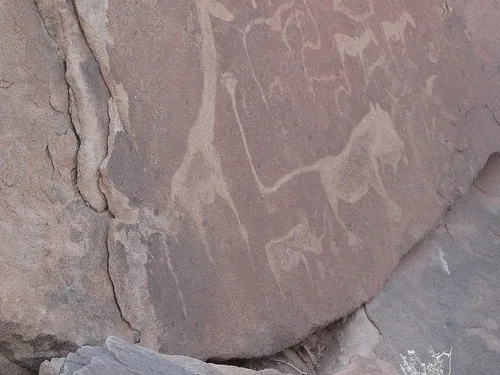
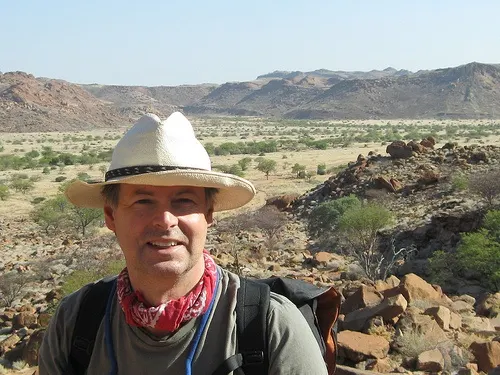
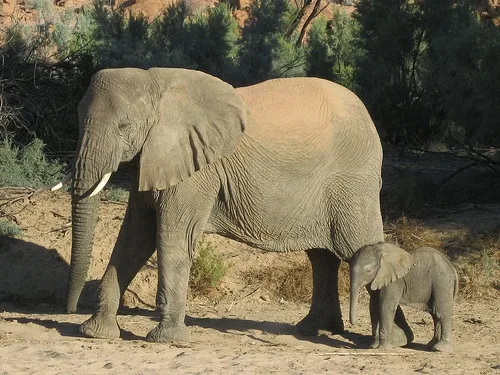
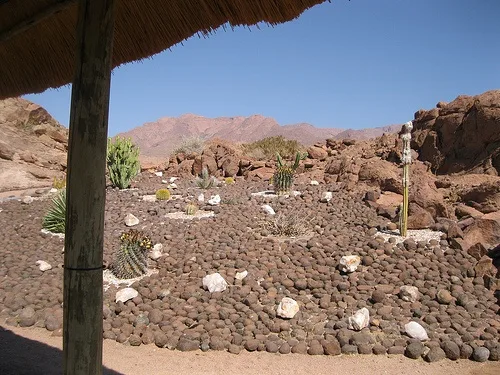
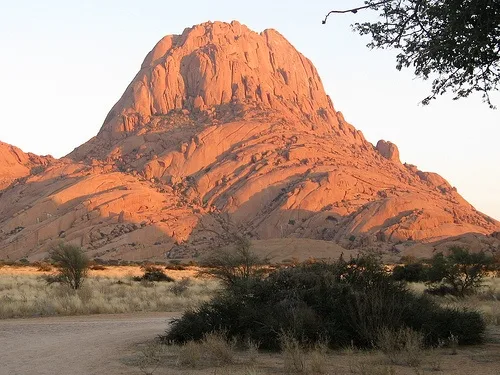
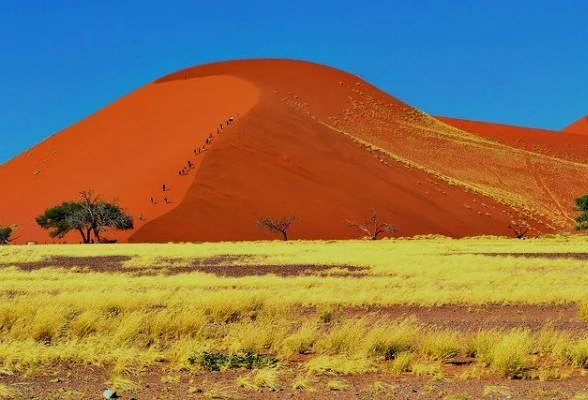

Moon
Monday 22nd of July 2013
I just love animals! And another news… I just found out that Manila Zoo has a cute elephant named Mali, and she is the only elephant in the Philippines! She has lived there for almost all of her lives, for more than 30 years. The zoo should feel like her sweet and cozy home now. But then, I read some articles in PETAAsiaPacific.com, and I noticed that Mali is in fact sad and lonely! Look at her here: https://www.facebook.com/FreeMali. She is like a prisoner, who cannot spend her days with her friends, roam in vast territories, and have delicious adequate food! She even suffers from foot problems. Why does she deserve this? :( Please Help Her!
A celebration of African music and culture in Festival Sur le Niger | Heather on her travels
Sunday 30th of December 2012
[...] Morocco – close to Europe but a world apart Voluntary work in Ghana, West Africa An encounter with the desert elephants of Namibia [...]
Where Heather travelled in 2012 - a year in photos | Heather on her travels
Saturday 29th of December 2012
[...] Read more about Guy’s Namibia Trip Not that old zebra crossing joke again! An encounter with the desert elephants of Namibia [...]
Sally@uktravelblog
Friday 26th of October 2012
I was there few years back at Namibia. It is so happy to see those elephants living in freedom. I just wish all other animals experience what these desert animals do.
Donna Hull
Sunday 23rd of September 2012
It's amazing to read how the elephants have adapted to a desert environment. Seeing Namibia through the eyes of adolescent girls must have been an interesting experience.
Heather
Wednesday 26th of September 2012
@Donna From what my husband told me the wildlife in Namibia is amazing and hardly any people there.